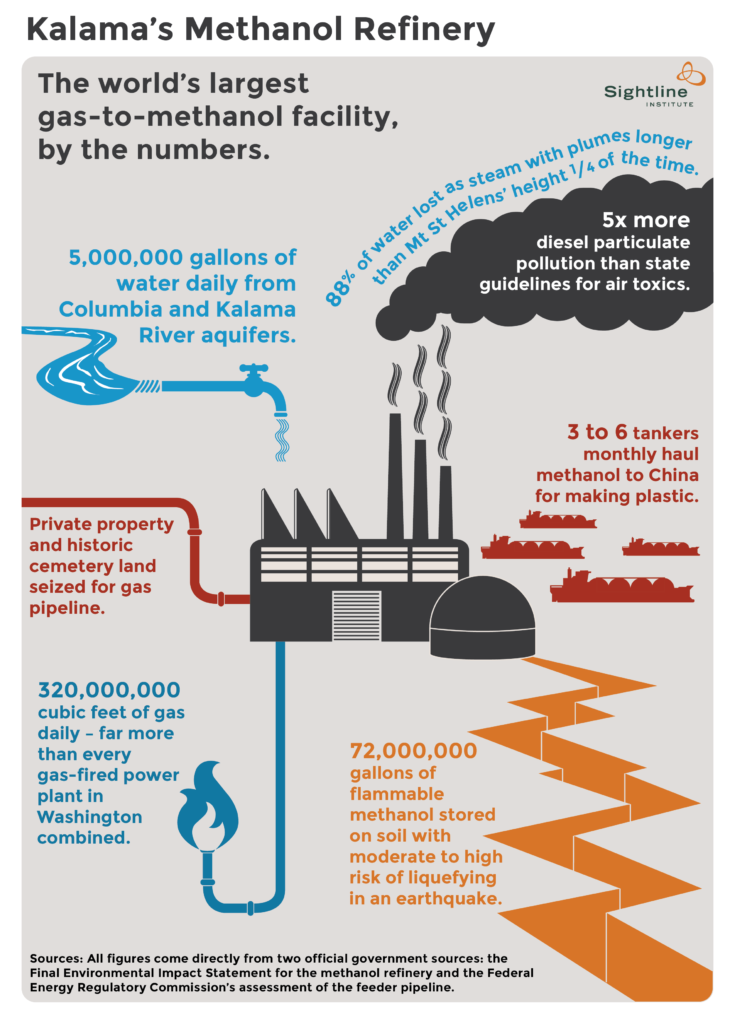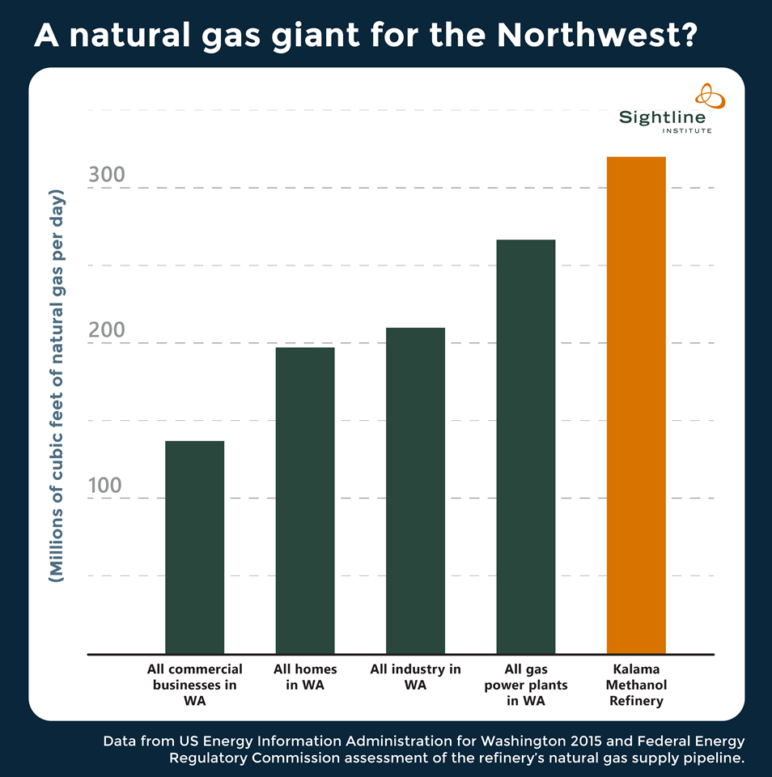By any measure, the petrochemical refinery slated for construction on the banks of the Columbia River in southwest Washington is a giant. Designed to convert large quantities of natural gas into methanol, the facility would ship tankers full of the product to China to be used for making plastics.
Although the facility proposed for Kalama is only about half the size of the gargantuan scheme that recently collapsed in Tacoma, the scale of the project’s ambitions are still staggering. In order to make clear some of the facts about the project, Sightline is publishing a graphic accounting of the proposed Kalama Methanol Refinery.

Below, you can find a full description of our sources and methodology.
The proposed facility at Kalama would be the largest methanol-producing facility in the world. According official project documents, the proposed refinery would produce up to 10,000 metric tons of methanol per day, or 3.6 million metric tons per year. The three largest plants already in existence appear to be Iran’s Kaveh mega methanol project (a two-million-ton-per-year gas-to-methanol plant) and a pair of facilities in Trinidad and Tobago: Methanol Holdings (Trinidad) Limited’s M5000 plant (1.89 million metric tons per year) and Methanex’s Atlas plant (1.7 million metric tons annually). As of 2014, Connell Group of China was apparently planning to build a two-plant complex in Texas or Louisiana that would be even bigger than Kalama’s (with each unit having the capacity to produce 3.6 million metric tons a year), but there is little current information about this project and it is not now operational.
Steam plumes would be longer than Mt St Helens’ height 1/4 of the time. As shown in Table 16 on page 60 of Appendix D to the Final Environmental Impact Statement, if the plant uses “ultra low emission” (ULE) technology, the steam plumes would 25 percent of the time stretch to 3,000 meters—that’s 9,842 feet compared to Mt St Helens, which stands 8,366 feet and is visible from hundreds of miles away. (If the plant uses “combined reforming” (CR) technology, an alternative means of producing methanol, it will produce steam plumes at least 4,000 meters long an estimated 34 percent of the time—that’s 13,123 feet compared to Mount Hood, which rises 11,250 feet high. And 12 percent of the time, the plumes would stretch 6,000 meters, nearly at long as Alaska’s Mount Denali is tall.)
Toxic air pollution with five times more diesel particulate pollution than Washington guidelines would issue from the Kalama methanol refinery. That’s according to figures in the Final Environmental Impact Statement, Table 4-6, where you can also find information about the plant’s other hazardous air pollution, including ammonia, carbon monoxide, nitrogen dioxide, and more.
Three to six tankers per month will carry the refinery’s petrochemical product down the Columbia River and across the bar at Astoria en route to China. Those vessel numbers are calculated from the annual figures given on page 2-14 of the project’s Final Environmental Impact Statement.
The risks of building on ground that has a moderate to high risk of liquefying in an earthquake can be found on page 3-7 of the Final Environmental Impact Statement. In this section, we also learn that:
Earthquake-induced settlement and lateral spreading due to liquefaction could affect structures at the project and result in related injury or death to personnel…. Lateral spreading would be most likely to affect the project elements located close to the river, such as the marine terminal, pump station, fire suppression water storage and pumps, infiltration pond, flush pond, and Ranney well.

The Kalama methanol refinery would consume 320 million cubic feet of natural gas per day, according to page 2 of the Federal Energy Regulatory Commission’s environmental assessment of the new natural gas pipeline that would be required to supply the refinery. (As shown in Chapter 7 of the Final Environmental Impact Statement, 290 million cubic feet of natural gas would be used daily to create methanol with the balance going to stoke an onsite gas-fired power plant.) For context, that’s more natural gas than is used by every gas-fired power plant in Washington, combined. It’s also more than is used by every industrial site in the state or every home in the state; it’s about twice as much as is used by every commercial business.
The feeder pipeline would require seizing private land, including an easement across a historic cemetery. The dispute with the Mount Pleasant Cemetery commissioners has been reported by the Longview Daily News, among other media sources.
The refinery would use 5 million gallons of water per day, according to page 5-19 in the Final Environmental Impact Statement if the operators use ULE technology. It would use “slightly less” if the plant operators opt for conventional technology. That’s an amount roughly equivalent to the consumption of 96,000 residents of Portland, Oregon, where officials estimate that a typical city dweller uses 52 gallons per day.
Thanks to Dan Serres and Jasmine Zimmer-Stucky of Columbia Riverkeeper for contributing research, to Tarika Powell for editorial review, and to Devin Porter at Goodmeasures.biz for designing the graphics.


Comments are closed.